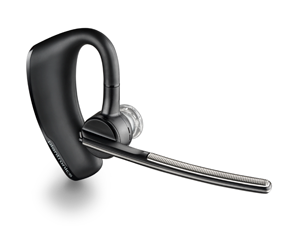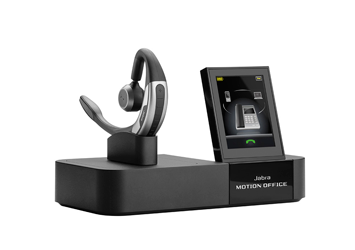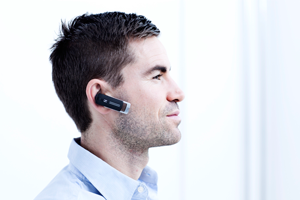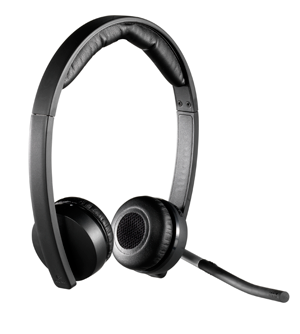
Mobile headsets are not just becoming smarter but are now an important piece of equipment for anyone that works either on the move or is permanently glued to their mobile device. The UC market has been experiencing strong growth and with the government committed to making flexible working schemes available to every employee this trend is likely to continue. Working from anywhere with any device has become the norm and having the right headset is key to keeping workers productive. Resellers should take note and make sure they are getting the most out of their headset offerings.
Plantronics Voyager Legend UC
 The Plantronics range has always done well and last year the Voyager Legend was probably the best UC headset out there. So what does a year and a half do to a headset like this? The major change is price, they have dropped slightly. This is actually not a bad thing as it is still excellent and will leave many mobile professionals happy for years to come!
The Plantronics range has always done well and last year the Voyager Legend was probably the best UC headset out there. So what does a year and a half do to a headset like this? The major change is price, they have dropped slightly. This is actually not a bad thing as it is still excellent and will leave many mobile professionals happy for years to come!
The carry case alone is snazzy personified as it doubles as a charging dock. The charging cable magnetically attaches to the device which is one of those small touches which gives the Legend that extra bit of class. As you can imagine paring the device is a doddle with the added bonus of being able to pair two devices simultaneously! This product was also specifically optimised for Lync.
The audio quality is excellent given the three microphones in the boom arm and it sits on the ear with ease although it isn’t the lightest headset in the world. The product can be worn on both ears and although the microphone boom had limited swivel it has no negative impacts on audio quality. In noisy environments the headset performs well generally.
The ability to transfer calls between the headset and smartphone is easily done by just taking the headset off, you can then transfer it back by putting the headset on again. This feature works extremely well.
Pros – Audio quality, Call transfers, great battery life, solid piece of kit.
Cons – Ear piece volume could go higher.
Jabra Motion Office – Editors Pick!
 When it comes to headsets Jabra has always done a good job, but I think they may have just outdone themselves. Launched earlier this year the Motion Office delivers triple connectivity for mobile, softphone or deskphone through Bluetooth technology. This can be used specifically as a solution for knowledge workers, remote teams and employees sharing an office workspace. This specific solution combines the Jabra Motion UC headset with a base station.
When it comes to headsets Jabra has always done a good job, but I think they may have just outdone themselves. Launched earlier this year the Motion Office delivers triple connectivity for mobile, softphone or deskphone through Bluetooth technology. This can be used specifically as a solution for knowledge workers, remote teams and employees sharing an office workspace. This specific solution combines the Jabra Motion UC headset with a base station.
The Jabra Motion Office provides users with a UC-compatible headset that enables enhanced productivity and freedom of movement due to its connectivity options. Being a multiuse headset it supports the working trend of moving from a fixed desk scenario to a hot-desk or flexible working environment by plugging into any Jabra Motion Office base unit to work.
The great thing about Jabra is they have thought of everything a mobile/ office worker could want here. The headset comes with NFC so it’s a cinch to pair to your mobile and to pair with the base station takes approximately twelve seconds! The headset itself is a durable quality product.
The Motion comes with various gel ear buds so you can select what suits you best. Once on it is comfortable enough but you definitely know you are wearing it. Answering calls is easy peasy and there is a button to answer, reject or hang up calls as they come in.
It’s actually hard to justify taking this product out of your ear... if you are stepping away from your desk it has 100 metre range, if you are going further than that then it pairs with your smart phone. Inside work hours there isn’t a reason to miss any calls whatsoever!
I reviewed the Motion UC as a standalone headset previously and while it was very good at the time the base station turns it into a true UC powerhouse which is also exceptionally stylish.
Pros – Feature rich, easy to use, triple connectivity, durability
Cons – Pricey for the headset and base combo
 Sennheiser PRESENCE UC
Sennheiser PRESENCE UC
 The Presence is a premium product which combines the simplicity and advanced technology that we have come to expect from Sennheiser. It comes in a tiny case which holds the device, usb dongle and the usb carging cable. They have also dispensed with a mains cable but do include a car adapter... if you are a mobile worker then the chances are you are spending a lot of time in the car.
The Presence is a premium product which combines the simplicity and advanced technology that we have come to expect from Sennheiser. It comes in a tiny case which holds the device, usb dongle and the usb carging cable. They have also dispensed with a mains cable but do include a car adapter... if you are a mobile worker then the chances are you are spending a lot of time in the car.
The noise cancelling technology in this headset works very well and although I used it mostly in the car no one could even tell I was driving! This is probably the lightest headset in this group and it still manages to pack a whopping 10 hours of call time per charge.
Optimised for Microsoft Lync it also has a range of 25 metres! The beauty of this product is the simplicity of its design but underneath packs a feast of technology. The problem with this device is it doesn’t feel as solid as others out there. Not one for wearing in the office olympics! It does come with a two year warranty however.
Pros – Wind Cancelling Technology, Lightweight, Call time battery life
Cons – Doesn’t feel durable
Logitech Wireless Headset Dual H820e
 Logitech subscribes to the less is more when it comes to their packaging. After opening a box coloured the most boring shade of brown I have ever seen I got to work with setting up this little beauty. So let’s make one thing clear off the bat, this isn’t strictly a mobile headset… what it does do is connect to either a regular phone or a computer for VoIP calls. The Dual H820e is for busy offices and call centres - where service is essential, This means that audio clarity, as well as comfort for the wearer, is a top priority. In essence it allows workers to be more mobile, just within the confines of their office!
Logitech subscribes to the less is more when it comes to their packaging. After opening a box coloured the most boring shade of brown I have ever seen I got to work with setting up this little beauty. So let’s make one thing clear off the bat, this isn’t strictly a mobile headset… what it does do is connect to either a regular phone or a computer for VoIP calls. The Dual H820e is for busy offices and call centres - where service is essential, This means that audio clarity, as well as comfort for the wearer, is a top priority. In essence it allows workers to be more mobile, just within the confines of their office!
Following in the footsteps of other headsets in the Logitech range this does have a certain professional feel about it. Easily adjustable and comfortable this is great for wearing for long periods of time.
This is a binaural headset, which means that there are ear pieces for both ears, to help mask surrounding noises. The microphone incorporates echo cancellation and noise-cancelling technology, making voice calls clear and distinct. An in-call LED indicator light lets your colleagues know when you’re not to be disturbed, and there are also visual incoming-call alerts to make sure you don’t miss an important call. Battery life is decent, at around 10 hours, and it comes with an attractive base station that can be used to quickly charge the headset when not in use.
The headset uses DECT technology for the wireless connection, so there’s no interference with wireless networks or other devices. It also has a range of 100m which is great for those workers that like to wander around when on calls.
Audio quality is superb. Callers reported that it sounded as clear as any handsets they had used, with barely any background noise.
Pros – Great audio quality, comfortable, good battery life
Cons – Pricey, no mobile connectivity,
Getting the Sell Right
Introducing headsets into a solution sale is all too often an afterthought for resellers. Here we asked suppliers why they thought headsets needed to be introduced into a sale early on. Paul Dunne, Head of Channel UK & Ireland, Plantronics said “Typically, resellers should introduce headsets at the system design stage when they have an opportunity to explain to the client how the correct devices will increase user satisfaction and drive the adoption of the technology. If device selection is left until the system has been deployed there is a real risk that the solution will fail and the client will not achieve the ROI they expect.”
Anne Marie Ginn, Senior Category Manager, Unified Communications, Logitech for Business continued “Introducing headsets as early as possible to the sales cycle will allow the end-user time to evaluate different vendor options and discover which application best suits their needs for various work group profiles. There are a number of options open to end-users, including office and mobile based headsets, and introducing the products early will allow resellers/dealers to take a more consultative approach to their sales.”
Nigel Dunn, Managing Director, Jabra Business Solutions UK & Ireland added “Headsets should always be introduced as early into the sales cycle as possible. When deploying Unified Communications, headsets are a vital component of the complete solution offering and should be discussed and introduced at initial Proof of Concept (POC) stage. This will help the customer to ascertain which device or selection of devices best suits their user requirements, whilst allowing the reseller to provide the right solution, without the issue of cost-constraints if left to the end of the roll-out.”
Optimised…for What?
It would seem every headset these days is optimised for some sort of UC platform, but does this really make a difference? What are the major benefits of going for specifically optimised headsets over regular ones? We asked some top suppliers what they thought.
Nigel Holland, Product Manager for Sennheiser UK said, “VoIP applications present particular challenges relating to echo. Optimised solutions have been designed and proven to specifically meet strict performance requirements in terms of audio performance, such as wideband capability for a more natural conversation, connectivity and usage behaviour to deliver a fist class user experience. A classic example is the Optimised for Microsoft Lync qualification. Headsets bearing the Optimised for Microsoft Lync label deliver a high quality, fully compatible solution providing peace of mind to the customer.”
Dunn adds “UC-optimised audio devices have been specifically manufactured to be compatible with the various UC platforms available and they provide increased functionality, such as call control from the audio device for the optimum communication experience.
UC-optimised devices are also plug-and-play, making set-up and roll-out across the estate quick and easy for faster user adoption and ROI. In large deployments this is particularly advantageous as optimised audio devices simplify the IT effort due to their simple plug-and-play usage. Another way to support this is mass-deployment software upgrades such as Jabra Xpress which helps IT to manage and maintain their infrastructure quickly and efficiently.”
Headset Feature Wish list
Whether headsets are at the higher or lower end of the market, there are some essential functions that they must include to remain competitive. Design for all-day comfort and durability is a must for IT decision makers looking to equip large teams, even on a tight budget.
Anne Marie Ginn commented “It is ideal if headsets are built with acoustic echo cancellation and noise-cancelling microphones so that you can hear and be heard in noisy places, especially as open-plan offices become more prevalent.
Essentially, products should have the ability to answer an end-to-end call directly from all UC audio models, which means being compatible with Microsoft Lync and Cisco amongst others. If customers are paying a higher price for products then it’s important for headsets to differentiate beyond comfort and style, with added features like DECT spectrum wireless connectivity that won’t interfere with Wi-Fi devices in the office.
Not only that, resellers need to be aware that there are compliance issues to be considered when recommending headsets for a business environment.”
Paul Dunne adds “Every UC headset must be engineered to work seamlessly with the UC system and withstand the rigours of flexible and mobile working. They should also have the backup of a world class and global post-sale support system to ensure that the new technology is quickly and properly adopted by the workforce.”

